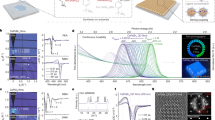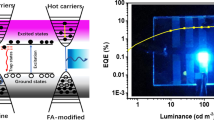Abstract
Colloidal quantum dot (QD) solids are emerging semiconductors that have been actively explored in fundamental studies of charge transport1 and for applications in optoelectronics2. Forming high-quality QD solids—necessary for device fabrication—requires substitution of the long organic ligands used for synthesis with short ligands that provide increased QD coupling and improved charge transport3. However, in perovskite QDs, the polar solvents used to carry out the ligand exchange decompose the highly ionic perovskites4. Here we report perovskite QD resurfacing to achieve a bipolar shell consisting of an inner anion shell, and an outer shell comprised of cations and polar solvent molecules. The outer shell is electrostatically adsorbed to the negatively charged inner shell. This approach produces strongly confined perovskite QD solids that feature improved carrier mobility (≥0.01 cm2 V−1 s−1) and reduced trap density relative to previously reported low-dimensional perovskites. Blue-emitting QD films exhibit photoluminescence quantum yields exceeding 90%. By exploiting the improved mobility, we have been able to fabricate CsPbBr3 QD-based efficient blue and green light-emitting diodes. Blue devices with reduced trap density have an external quantum efficiency of 12.3%; the green devices achieve an external quantum efficiency of 22%.
This is a preview of subscription content, access via your institution
Access options
Access Nature and 54 other Nature Portfolio journals
Get Nature+, our best-value online-access subscription
$29.99 / 30 days
cancel any time
Subscribe to this journal
Receive 12 print issues and online access
$259.00 per year
only $21.58 per issue
Buy this article
- Purchase on Springer Link
- Instant access to full article PDF
Prices may be subject to local taxes which are calculated during checkout




Similar content being viewed by others
Data availability
The authors declare that the main data supporting the findings of this study are available within the letter and its Supplementary Information. Extra data are available from the corresponding authors upon reasonable request.
References
Kagan, C. R. & Murray, C. B. Charge transport in strongly coupled quantum dot solids. Nat. Nanotechnol. 10, 1013–1026 (2015).
A decade of perovskite photovoltaics. Nat. Energy 4, 1 (2019).
Kagan, C. R., Lifshitz, E., Sargent, E. H. & Talapin, D. V. Building devices from colloidal quantum dots. Science 353, 885–892 (2016).
Kovalenko, M. V., Protesescu, L. & Bodnarchuk, M. I. Properties and potential optoelectronic applications of lead halide perovskite nanocrystals. Science 358, 745–750 (2017).
Yuan, M. et al. Perovskite energy funnels for efficient light-emitting diodes. Nat. Nanotechnol. 11, 872–877 (2016).
Liu, Y. et al. Efficient blue light-emitting diodes based on quantum-confined bromide perovskite nanostructures. Nat. Photon. 13, 760–764 (2019).
Chiba, T. et al. Anion-exchange red perovskite quantum dots with ammonium iodine salts for highly efficient light-emitting devices. Nat. Photon. 12, 681–687 (2018).
Nedelcu, G. et al. Fast anion-exchange in highly luminescent nanocrystals of cesium lead halide perovskites (CsPbX3, X = Cl, Br, I). Nano Lett. 15, 5635–5640 (2015).
Akkerman, Q. A. et al. Tuning the optical properties of cesium lead halide perovskite nanocrystals by anion exchange reactions. J. Am. Chem. Soc. 137, 10276–10281 (2015).
Kovalenko, M. V., Scheele, M. & Talapin, D. V. Colloidal nanocrystals with molecular metal chalcogenide surface ligands. Science 324, 1417–1420 (2009).
Boles, M. A., Ling, D., Hyeon, T. & Talapin, D. V. The surface science of nanocrystals. Nat. Mater. 15, 141–153 (2016).
Bodnarchuk, M. I. et al. Rationalizing and controlling the surface structure and electronic passivation of cesium lead halide nanocrystals. ACS Energy Lett. 4, 63–74 (2019).
De Roo, J. et al. Highly dynamic ligand binding and light absorption coefficient of cesium lead bromide perovskite nanocrystals. ACS Nano. 10, 2071–2081 (2016).
Krieg, F. et al. Colloidal CsPbX3 (X = Cl, Br, I) nanocrystals 2.0: zwitterionic capping ligands for improved durability and stability. ACS Energy Lett. 3, 641–646 (2018).
Dong, Y. et al. Precise control of quantum confinement in cesium lead halide perovskite quantum dots via thermodynamic equilibrium. Nano Lett. 18, 3716–3722 (2018).
Nenon, D. P. et al. Design principles for trap-free CsPbX3 nanocrystals: enumerating and eliminating surface halide vacancies with softer Lewis bases. J. Am. Chem. Soc. 140, 17760–17772 (2018).
Pan, J. et al. Highly efficient perovskite-quantum-dot light-emitting diodes by surface engineering. Adv. Mater. 28, 8718–8725 (2016).
Wu, K. et al. Ultrafast interfacial electron and hole transfer from CsPbBr3 perovskite quantum dots. J. Am. Chem. Soc. 137, 12792–12795 (2015).
Becker, M. A. et al. Bright triplet excitons in caesium lead halide perovskites. Nature 553, 189–193 (2018).
Tao, S. et al. Absolute energy level positions in tin- and lead-based halide perovskites. Nat. Commun. 10, 2560 (2019).
Gong, X. et al. Contactless measurements of photocarrier transport properties in perovskite single crystals. Nat. Commun. 10, 1591 (2019).
Whitham, K. et al. Charge transport and localization in atomically coherent quantum dot solids. Nat. Mater. 15, 557–563 (2016).
Li, Z. et al. Modulation of recombination zone position for quasi-two-dimensional blue perovskite light-emitting diodes with efficiency exceeding 5%. Nat. Commun. 10, 1027 (2019).
Leijtens, T. et al. Carrier trapping and recombination: the role of defect physics in enhancing the open circuit voltage of metal halide perovskite solar cells. Energy Environ. Sci. 9, 3472–3481 (2016).
Hou, S., Gangishetty, M. K., Quan, Q. & Congreve, D. N. Efficient blue and white perovskite light-emitting diodes via manganese doping. Joule 2, 2421–2433 (2018).
Xing, J. et al. Color-stable highly luminescent sky-blue perovskite light-emitting diodes. Nat. Commun. 9, 3541 (2018).
Chiba, T. et al. High-efficiency perovskite quantum-dot light-emitting devices by effective washing process and interfacial energy level alignment. ACS Appl. Mater. Interfaces 9, 18054–18060 (2017).
Gong, X. et al. Highly efficient quantum dot near-infrared light-emitting diodes. Nat. Photon. 10, 253–257 (2016).
Shen, H. et al. Visible quantum dot light-emitting diodes with simultaneous high brightness and efficiency. Nat. Photon. 13, 192–197 (2019).
Lee, W. et al. Ultralow thermal conductivity in all-inorganic halide perovskites. Proc. Natl Acad. Sci. USA 114, 8693–8697 (2017).
Maes, J. et al. Light absorption coefficient of CsPbBr3 perovskite nanocrystals. J. Phys. Chem. Lett. 9, 3093–3097 (2018).
de Mello, J. C., Wittmann, H. F. & Friend, R. H. An improved experimental determination of external photoluminescence quantum efficiency. Adv. Mater. 9, 230–232 (1997).
Ilavsky, J. Nika: software for two-dimensional data reduction. J. Appl. Crystallogr. 45, 324–328 (2012).
Jiang, Z. GIXSGUI: a MATLAB toolbox for grazing-incidence X-ray scattering data visualization and reduction, and indexing of buried three-dimensional periodic nanostructured films. J. Appl. Crystallogr. 48, 917–926 (2015).
Proppe, A. H. et al. Picosecond charge transfer and long carrier diffusion lengths in colloidal quantum dot solids. Nano Lett. 18, 7052–7059 (2018).
Cademartiri, L. et al. Size-dependent extinction coefficients of PbS quantum dots. J. Am. Chem. Soc. 128, 10337–10346 (2006).
Acknowledgements
This work was supported by the Ontario Research Fund–Research Excellence Program and the Natural Sciences and Engineering Research Council of Canada (NSERC, grant number 537463-18). M.I.S. acknowledges the support of the Banting Postdoctoral Fellowship Program, administered by the Government of Canada. We acknowledge financial support from the Natural Science Foundation of China (numbers 51821002 and 91733301) and the Collaborative Innovation Centre of Suzhou Nano Science and Technology. Y.-K.W. also acknowledges the financial support of the China Scholarship Council (number 201806920067). We thank Huawei Canada for their financial support. Z.-H.L. and all co-authors from the Department of Materials Science and Engineering at the University of Toronto acknowledge the financial support from the Natural Sciences and Engineering Research Council of Canada (NSERC, grant number 216956-12) and the National Natural Science Foundation of China (grant number 11774304).
Author information
Authors and Affiliations
Contributions
Y.D., Y.-K.W. and F.Y. conceived the study. Y.D. and Y.-K.W. synthesized the CsPbBr3 perovskite QDs and developed the ligand exchange method. Y.D. performed steady-state absorption and photoluminescence spectra measurements, time-correlated single-photon counting measurements and transient absorption spectroscopy measurements. Y.-K.W. and F.Y. fabricated the LED devices, performed XRD measurements and characterized the LEDs. B.C., S.-W.B. and M.W. performed TEM, SEM and STEM imaging. J.F. performed FTIR spectroscopy measurements. L.K.S. performed the TGA. M.-J.C. and M.C. performed the ζ-potential measurements. F.Y., P.L. and H.T.K. performed XPS measurements. R.Q.-B. and A.J. performed GISAXS measurements. Y.H., Y.L., B.S., S.L., D.M., P.T., F.D., H.E., E.K. and S.H. contributed to device fabrication and data analyses. Y.D. and O.V. performed the device simulation. M.I.S., Z.-H.L and E.H.S. supervised the project. All authors discussed the results and commented on the manuscript.
Corresponding authors
Ethics declarations
Competing interests
The authors declare no competing interests.
Additional information
Publisher’s note Springer Nature remains neutral with regard to jurisdictional claims in published maps and institutional affiliations.
Supplementary information
Supplementary Information
Supplementary Figs. 1–20, discussion, Tables 1–8 and refs. 1–15.
Rights and permissions
About this article
Cite this article
Dong, Y., Wang, YK., Yuan, F. et al. Bipolar-shell resurfacing for blue LEDs based on strongly confined perovskite quantum dots. Nat. Nanotechnol. 15, 668–674 (2020). https://doi.org/10.1038/s41565-020-0714-5
Received:
Accepted:
Published:
Issue Date:
DOI: https://doi.org/10.1038/s41565-020-0714-5
This article is cited by
-
Bright and stable near-infrared lead-free perovskite light-emitting diodes
Nature Photonics (2024)
-
Manipulating solvent fluidic dynamics for large-area perovskite film-formation and white light-emitting diodes
Nature Communications (2024)
-
Proton-Prompted Ligand Exchange to Achieve High-Efficiency CsPbI3 Quantum Dot Light-Emitting Diodes
Nano-Micro Letters (2024)
-
Lead-free perovskites-based photonic synaptic devices with zero electric energy consumption
Science China Information Sciences (2024)
-
Towards micro-PeLED displays
Nature Reviews Materials (2023)



